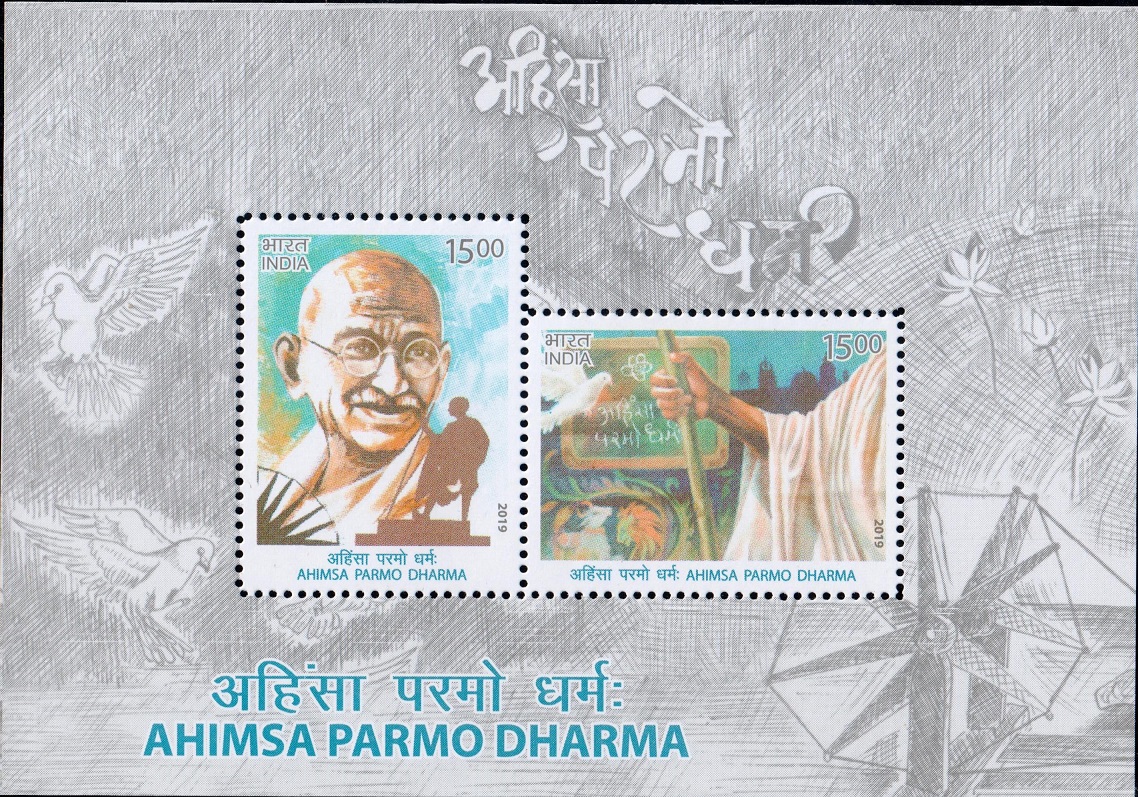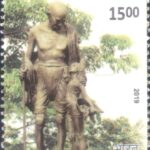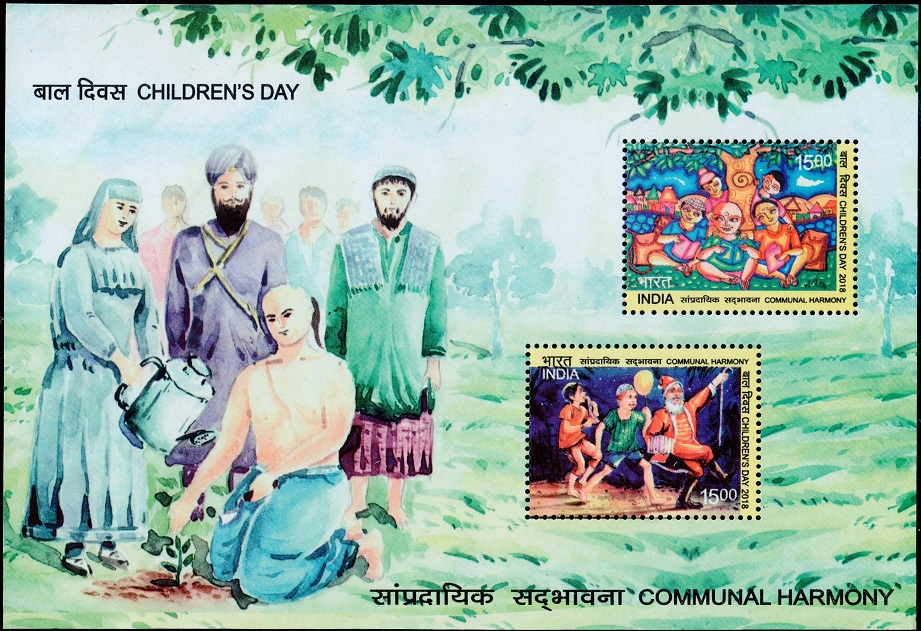
Ahimsa Parmo Dharma
Complete set of 2 nos. of commemorative postage stamps on ‘Ahimsa Paramo Dharma‘, a Sanskrit phrase popularized by Mahatma Gandhi :


 Issued by India
Issued by India
Issued on Jun 17, 2019
Issued for : Department of Posts is proud to issue a set of two Commemorative Postage Stamps on Ahimsa Parmo Dharma, as a tribute to Mahatma Gandhi during his 150th birth anniversary celebrations. The date of issue i.e. 17.06.2019 is based on the date of establishment of Sabarmati Ashram (i.e. 17.06.1917). The First Day Cover & Brochure depict Warli Art that adorns the walls of the Ashram.
Credits :
Stamps/Miniature Sheet/FDC/Brochure/Cancellation Cachet : Smt. Nenu Gupta, based on selected entries received from participants.
Type : Miniature Sheet, Mint Condition
Colour : Multi Colour
Denomination : 1500 Paise (2)
Stamps Printed : 500000 each
Miniature sheets printed : 110000
Printing Process : Wet Offset
Printer : India Security Press, Nashik
About :
- Department of Posts has been conducting stamp design competitions/photography competitions on various themes since 2015 at the national level. Based on the entries received from participants, stamps are designed and released. Selected participants are given cash awards. This time, a nationwide stamp design competition on the theme “Ahimsa Parmo Dharma” was conducted. The theme was chosen in consonance with the 150th Birth Anniversary celebrations of the Father of our Nation, Mahatma Gandhi. The competition elicited tremendous response and the Department is thankful to all participants who have made this competition successful.
- Entries from participants were invited in two categories of age groups of (i) upto 18 years and (ii) above 18 years. Philatelic items viz. Stamps & Miniature Sheet have been designed on the basis of selected entries. The first three winners in the first category i.e. upto 18 years are Ms. Prachi, Master Vikash, Master Sukdev Roy. Five consolation winners are Master Tushar, Master Rajtanu Dasgupta, Master Vaibhav Maurya, Master Hemant Kumar, Master Sujit Kumar. The first three winners in the second category i.e. above 18 years are Sh. Purushottam J. Pawar, Sh. Ravindra Somanath, Sh. P. Mutharas. Five consolation prize winners are Ms. Swarda Deshmukh, Sh. Suraj Kumar Palo, Sh. Prashant A. Maru, Sh. Suresh Kumar Maharana, Sh. Amit Singh Kushwaha.
- Ahimsa Parmo Dharma is the philosophy of life that was followed by the Father of our Nation, Mahatma Gandhi. The preaching of Gandhiji and his principles of life are a way of living for many people. Non-Violence is the philosophy of life advocated by Gandhiji during the struggle for freedom wherein he revolted against the British through Satyagraha. After the British took over the rule in India, their cruelty towards Indian natives knew no bounds. They took over our land and other resources. Many other freedom fighters had a revolutionary ideology of protesting against the British rule. Gandhiji was not in favour of violence and believed that Ahimsa or peaceful non-violence is the best way to register protest against violence and injustice.
- Ahimsa essentially means not to hurt anyone physically. Himsa advocates reaching one’s goals even if it is through the means of violence. In today’s day and age of cut-throat competition, many youngsters forget that it is important not to hurt anyone along the way. Even when we speak about terrorism and anti-national activities, himsa is the root cause. Its results are never good. War has only destroyed humanity and the beauty of life. It gives no value to peaceful co-existence but paves the way for hatred and blood-shed.
- The Father of our Nation, Mahatma Gandhi sincerely believed that non-violence or ahimsa is the strongest force of mankind and that it could even turn a demon into a saint, after all this body of ours is the temple of living gods. His methods of protesting against the British advocated non-violence. He emphasised on Satyagraha as the method of protest for seeking the truth and fought for the cause of the peasants of Champaran, who were exploited by their landlords. Dandi March which was a rebellion against taxes imposed on the basic necessity, salt, was again a peaceful method of protest promoted by Gandhiji who wanted the tax imposed on salt to be removed. To this end, he and 78 Indians took off to Dandi in March 1930 on foot, to extract salt from the sea, which was illegal at that time.
- Gandhiji also revolted through Non-cooperation Movement in which the Indian workers refused to work but did not resort to any violent means of protest. Further, Indian citizens refused to work in British institutions. Lawyers, clerks, doctors, factory workers, merchants, etc. refused to work and students revolted against studying in British colleges and schools. This movement was later promoted by burning foreign cloth and other foreign goods and taking over wearing Khadi, an Indian-spun, handwoven cloth. Even though this movement lasted only a short while, it shook the British. In fact, it placed them in a damned-if-you-do and damned-if-you-don’t-dilemma. Such was the power of non-violent Satyagraha.
- Gandhiji, even now, inspires many people to follow his path of Non-Violence. In fact, he has inspired several civil rights and independence movements across the world. He is truly known as the apostle of peace and non-violence.
- Text : Ms. Shaili Dhagat.








Muze indian navy ke post stamp chiye kya muze mil sakte hai kya?
Muze indian navy ke stamp chahiye plz